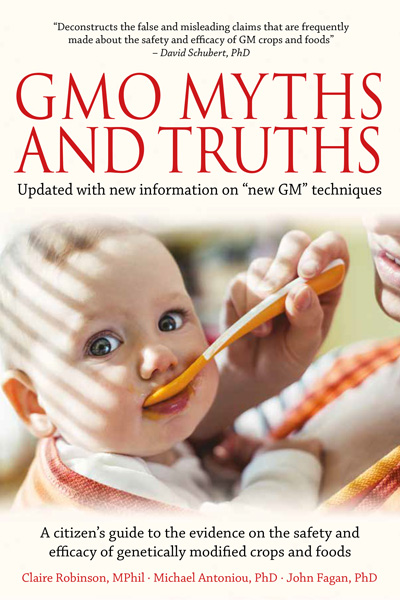Below (item 2) is the abstract of an interesting new study which has implications for any animal or human that eats a GM food. In fact, it brings new light to the old truism, "You are what you eat".
The study shows that we incorporate genetic information from the food we eat and that ingested nucleic acids, such as DNA and RNA, can have physiological influences.
The study is yet another nail in the coffin of the already discredited 'safety assessment' process for GM foods in the EU and elsewhere. These assessments do not consider the effects described.
Item 1 is a compilation of comments on the paper from scientists.
---
---
1. Comments on new study (below) from scientists
This is a very interesting discovery. In the light of this, a GM crop incorporating miRNA knock-down technology should be evaluated for gene expression-disturbing effects in the animals/humans who eat it. On a more general note, this makes another strong link between what we eat and our gene expression profile that could either lead to health or disease.
Micro RNA (miRNA) and short interfering RNA (siRNA) molecules are part of the naturally occurring "RNA interference" (RNAi) system found in both plants and animals. miRNA and siRNA molecules bind to specific mRNA targets that results in them being destroyed with the final outcome in effect being that expression from a given gene is reduced or virtually eliminated ("knock-down"). Note: as a reminder, mRNA is the RNA copy of a gene with the information within which the cell uses to synthesise a required protein. So as you knock-down (reduce) levels of a given mRNA via binding of an miRNA or siRNA you reduce or eliminate the amount of protein product that is encoded in the gene/mRNA.
It is important to note that miRNA and siRNA are naturally occurring systems that cells use to control levels of gene expression. However, miRNA and siRNA molecules can be custom-designed for a mRNA target of choice and delivered via GM approaches to the desired cells or organism.
The totally surprising finding of the study in question is that miRNA molecules are not destroyed during digestion, and, even more unexpectedly, can enter intact into the body of the animal that has eaten it, find an mRNA target (in this case in the liver) and interfere with (destroy/knock-down) its function.
So what this new study is implying from a GM perspective is that if a GM crop has been produced by the incorporation of a gene that will express a miRNA molecule to knock-down expression of a host or pest gene (see Auer C, Frederick R. Crop improvement using small RNAs: applications and predictive ecological risk assessments. Trends in Biotechnology. Nov 2009; 27(11): 644-651), then the potential negative effect of ingesting this crop by an animal or human also should now also be considered. miRNA and siRNA molecules in the crop can inadvertently switch off (knock-down) expression of a gene system in the animal or human who has eaten it, resulting in ill health.
miRNA or siRNA molecules are prone to "off-target" effects; that is, they can bind to and knock-down mRNA that they were not designed to target! So the picture of outcomes can get very complex. It will be interesting to see if this study can be replicated by looking at other miRNA molecules in plant foods and their effect on animals who eat them.
Even more interesting would be to see if a GM crop engineered with a novel miRNA results in this molecule being taken up with measurable effects by the animal in a feeding trial.
---
---
2. Zhang L, Hou D, Chen X, et al. Exogenous plant MIR168a specifically targets mammalian LDLRAP1: evidence of cross-kingdom regulation by microRNA. Cell Res. Sep 20 2011.
http://www.nature.com/cr/journal/vaop/ncurrent/full/cr2011158a.html
Our previous studies have demonstrated that stable microRNAs (miRNAs) in mammalian serum and plasma are actively secreted from tissues and cells and can serve as a novel class of biomarkers for diseases, and act as signaling molecules in intercellular communication. Here, we report the surprising finding that exogenous plant miRNAs are present in the sera and tissues of various animals and that these exogenous plant miRNAs are primarily acquired orally, through food intake. MIR168a is abundant in rice and is one of the most highly enriched exogenous plant miRNAs in the sera of Chinese subjects. Functional studies in vitro and in vivo demonstrated that MIR168a could bind to the human/mouse low-density lipoprotein receptor adapter protein 1 (LDLRAP1) mRNA, inhibit LDLRAP1 expression in liver, and consequently decrease LDL removal from mouse plasma. These findings demonstrate that exogenous plant miRNAs in food can regulate the expression of target genes in mammals.
PLEASE SUPPORT GMWATCH
If you like what we do, please help us do more. You can donate via Paypal or credit/debit card. Some of you have opted to give a regular donation. We greatly appreciate that as it helps place us on a more stable financial basis. Thank you for your support!
We incorporate genetic information from the food we eat - new study
- Details
Web Development By SCS Web Design










